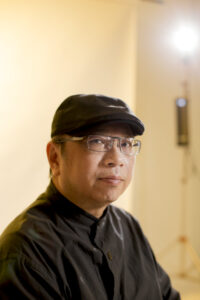Post
Huang: “Even in the most unstable circumstances, flourishing remains possible.”
On September 10, MEET inaugurated Rising in The Plate Shift, a collective exhibition of Taiwanese works curated by artist Hsin-Chien Huang. The exhibition presents five virtual reality works, two immersive projections, and two video works that show how digital art addresses cultural and social issues specific to the contemporary Taiwanese context.
Rather than surrendering to chaos, the artists involved in the project transform pressure into imagination and fracture into expressive form. Art becomes an instrument of resistance and renewal, a voice emerging from geological faults, affirming that even on unstable ground, life can always flourish (find out more about Rising in The Plate Shift here).
To better understand what lies behind Rising in The Plate Shift, we interviewed the curator of the collective, Hsin-Chien Huang.

In photo: Hsin-Chien Huang
On the geological metaphor and Taiwan’s condition
“The title “Rising in the Plate Shift” is inspired by Taiwan’s geological formation: our island was literally born from tectonic collision. This geological pressure that shaped our territory reflects Taiwan’s current reality. We constantly live and experience pressure from multiple directions.
This exhibition explores how artists transform chaos into creative expression. Just as geological forces shaped our island, today cultural forces are driving Taiwan toward a clearer definition of itself. We don’t just resist these challenges: we transform them into creative energy to elevate ourselves, flourish, and create something authentically our own.”
On curatorial vision and artist selection
“Every artist in this exhibition grapples with Taiwan’s complex identity. Take “Ekholux,” my latest VR work. It functions as what I call a “digital ark”: a space where Taiwan’s creative spirit can survive cultural fragmentation. The work explores how artificial intelligence and post-populist forces are shaping our world, posing fundamental questions about cultural preservation in the digital age.
The Painted Horizon represents a deeply personal archaeology of memory. The artist comes from Matsu, a remote archipelago of islands that embodies Taiwan’s frontier spirit. His grandfather was a fisherman who survived a devastating shipwreck: he was the sole survivor when his boat sank. That trauma became the catalyst for his transformation into a painter. His story exemplifies the central theme of our exhibition: how rupture generates creative possibilities, how survival transforms into art.
We have also included works that address Taiwan’s spiritual traditions. “Rice Dragon 360” translates Hakka worship rituals into virtual space, where rice traditionally scattered to represent the earth dragon becomes responsive digital particles. It raises profound questions about spiritual authenticity in the digital age: can sacred energy migrate from the physical to the digital while retaining its transformative power?”
On digital art as cultural resistance
“Digital art offers unprecedented access to the artistic experience. Unlike traditional museums, where you have to keep your distance from the works, VR invites you into the artist’s world. This intimacy creates new possibilities for cultural transmission and understanding.
For Taiwan, this technology serves a crucial purpose. Digital art transcends physical boundaries, allowing global audiences to experience Taiwan’s reality firsthand. When visitors put on VR headsets, they don’t just observe our culture—they inhabit it, feel it, and understand it from within.
This is especially important for younger generations who may feel disconnected from traditional practices. Through interactive installations such as “Digital Deities,” where AI technology merges images of visitors with traditional Door Gods, we create new pathways to ancestral wisdom. We are not abandoning tradition: we are finding new ways to make it alive, breathing, relevant”.
On Taiwan’s unique technological position
“Taiwan occupies a fascinating position in the global technology ecosystem. We are essential suppliers of semiconductors that power the AI revolution.
As artists, we want to explore the creative potential of AI before it becomes purely commercial. We are asking ourselves: what can AI do for cultural expression? How can we use these tools to preserve and transmit our heritage? How do we maintain human authenticity in an era of artificial intelligence?
The exhibition demonstrates this balance: it uses the world’s most advanced technology to explore timeless human concerns such as identity, memory, spirituality, and connection. We are showing that Taiwan is not just a technology supplier: we are cultural innovators who use technology to solve fundamental human problems”.
On art’s role in complex contexts
“Art speaks a universal language. When people experience our VR works, they understand Taiwan’s reality viscerally: the pressure, the resilience, the creativity born of constraint.
This exhibition is not propaganda: it is an honest exploration of what it means to live in an uncertain world. Every society faces pressures, but each must find its own way to transform those pressures into something meaningful. Taiwan’s approach is distinctly our own: technologically sophisticated but spiritually rooted, globally connected but locally anchored.
We hope that visitors will leave understanding that Taiwan’s story is not unique in its challenges, but in its responses. We are demonstrating that even in the most unstable circumstances, the choice to create, resist, and flourish remains possible. This is a message the world needs right now”.
